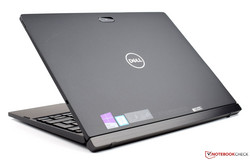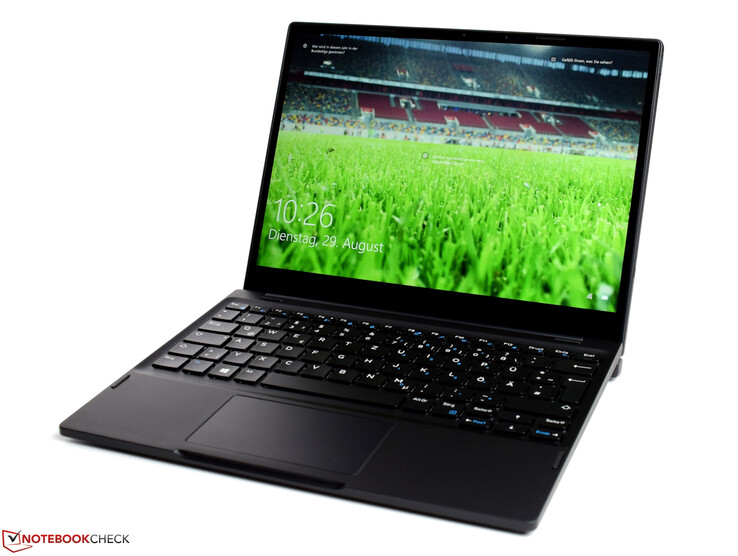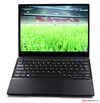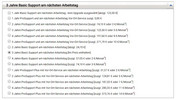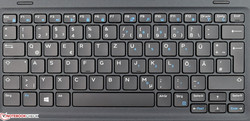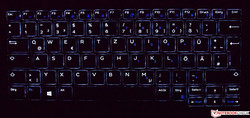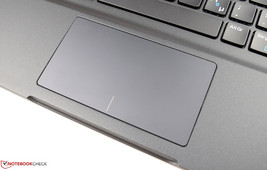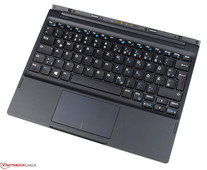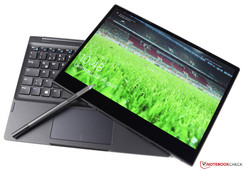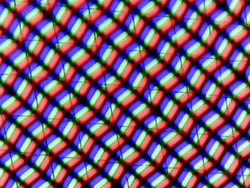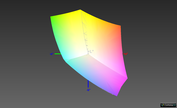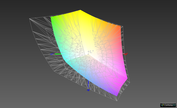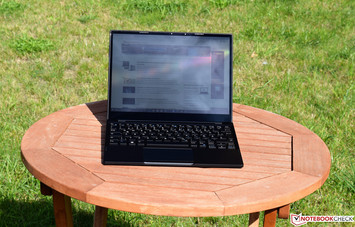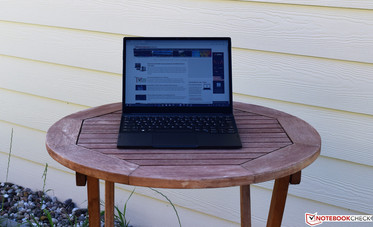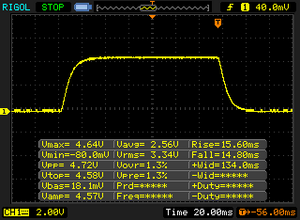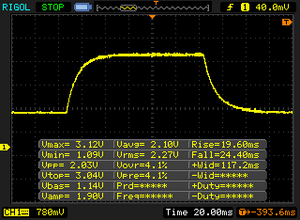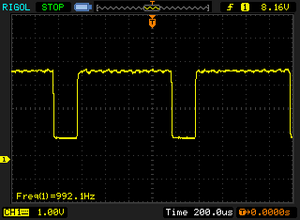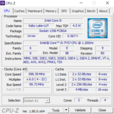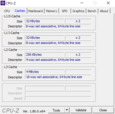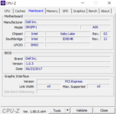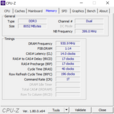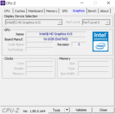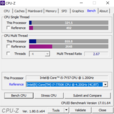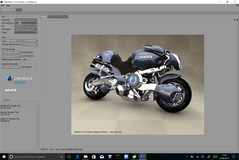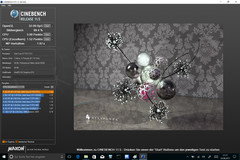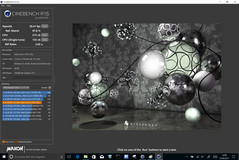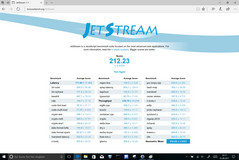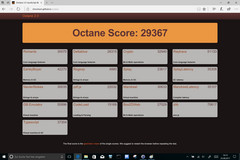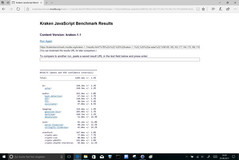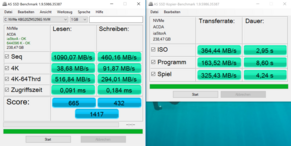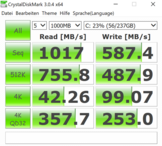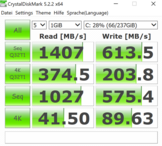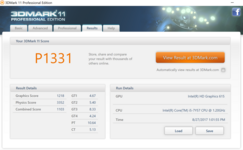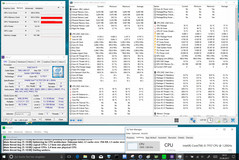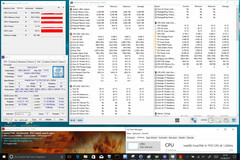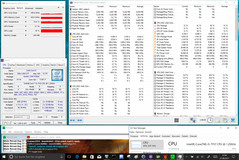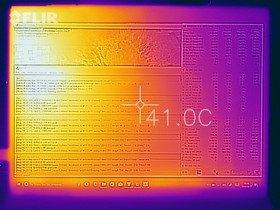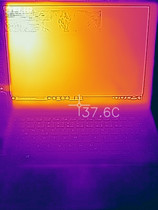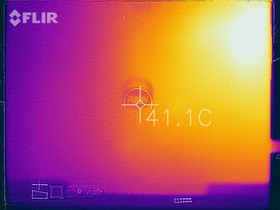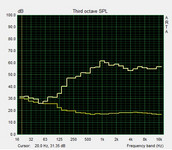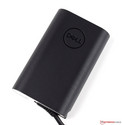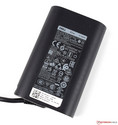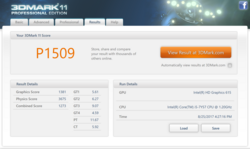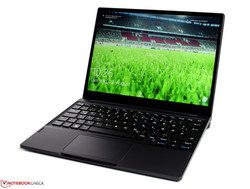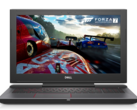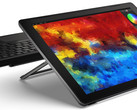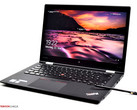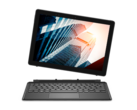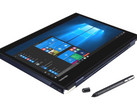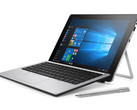Dell Latitude 7285 (i5-7Y57, 256 GB, 3K) Convertible Review

For the original German review, see here.
With its price, the Dell Latitude 7285 belongs to the high-end convertibles. It is based on a very energy-efficient dual-core CPU, the Intel Core i5-7Y57, which is an entry-level model at the same time. Anyone who likes it a little faster can also get the Dell Latitude 7285 with an Intel Core i7-7Y75. Both of the processors are dual-core CPUs of the Kaby-Lake family.
The package includes the tablet as well as a high-value keyboard dock, which turns the device into a laptop in no time. As a useful feature, the keyboard dock also contains an additional battery, which improves the battery life considerably. Also included is the Active Pen, whose functions are very versatile and will be continuously expanded by future Windows updates. Of course, all that has its price: at 2,300 Euros (~$2740; in the US it is available for about $1650), the Dell Latitude 7285 as equipped for our test is not really affordable. For the top configuration with the faster processor, 16 GB RAM, and 512 GB of storage, the price rises up to 2,900 Euros (~$3450). Here we should also mention that these prices already take a 35% rebate by the manufacturer into account.
The comparison devices are primarily high-priced, current convertibles from well-known manufacturers. The following table shows the comparison devices and their most important technical information.
| Microsoft Surface Pro 2017 | Lenovo ThinkPad X1 Yoga 2017 | Dell Latitude 12 5285 | Acer Switch 5 | Toshiba Portégé X20W | HP Elite x2 1012 G1 | |
| CPU | Intel Core i5-7300U | Intel Core i7-7600U | Intel Core i7-7600U | Intel Core i7-7500U | Intel Core i7-7600U | Intel Core m5-6Y54 |
| GPU | Intel HD Graphics 620 | Intel HD Graphics 620 | Intel HD Graphics 620 | Intel HD Graphics 620 | Intel HD Graphics 620 | Intel HD Graphics 515 |
| Panel | 12.3 inch 2736 x 1824 | 14 inch 2560 x 1440 | 12.3 inch 1920 x 1080 | 12 inch 2160 x 1440 | 12.5 inch 1920 x 1080 | 12.1 inch 1920 x 1280 |
| RAM | 8 GB | 16 GB | 16 GB | 8 GB | 16 GB | 8 GB |
| Storage | 256-GB SSD | 1024-GB SSD | 256-GB SSD | 512-GB SSD | 512-GB SSD | 256-GB SSD |
| Evaluation | 90 % | 88 % | 88 % | 84 % | 88 % | 87 % |
Case
The Dell Latitude 7285 impresses with elegance and perfect workmanship. All the surfaces have a soft-touch finish, which conveys a very high-value impression. The convertible, which consists of the tablet plus keyboard dock, is kept completely in black. Only a relief with the Dell Logo ornaments the tablet on the back.
In terms of stability, the device convinces with a very good stiffness, which makes warping it almost impossible. The Dell Latitude 7285 also shines in the pressure test due to its good build. We only found some small carelessness in the keyboard dock, which can be pressed in a small amount. However, this can be considered normal, so that it does not give cause for any negative points in our evaluation.
The magnetic connection between tablet and dock is so strong that you have to use both hands to separate the two components. In contrast to the Dell XPS 12 9250, the angle of the tablet can be adjusted without any problem. Due to the removable display, Dell foregoes their well-known 360-degree hinges. As a special feature, the keyboard dock offers an additional battery, which prolongs the battery life considerably.
Size Comparison
Since the Dell Latitude 7285 is a convertible, the values specified here include the keyboard dock. In closed state, we measure 19 mm (~0.75 in) at the thickest point, which makes the Dell Latitude 7285 come out the thickest. Yet the device together with its keyboard does not appear bulky, since if we look only at the tablet, the thickness is merely 7.25 mm (~0.3 in). With 1.4 kg (~3 lb) overall, the Dell Latitude 7285 brings exactly the same weight to the scale as the Lenovo ThinkPad X1 Yoga. Without the keyboard, the weight is only 680 grams (~1.5 lb).
Features
The connection equipment is good and includes current, future proof connections. Unfortunately, there are no additional connections in the keyboard. All the connections are on the tablet, with most of them on the left side. We can easily recognize the two USB Type-C connections that support Thunderbolt 3. Those serve as the charging ports at the same time, to run the device with an external power supply. Right next to them are the slots for a microSD and a Micro-SIM card, which both have a protective cover. On the right side, we find only the provision for a Noble security lock to secure the device.
Due to space constraints, the device does not offer a standard USB connection but the corresponding adapter is included.
SD Card Reader
The microSD card reader communicates at USB 2.0 speeds, which causes the Dell Latitude 7285 to fall slightly behind the competition. The Lenovo ThinkPad X1 Yoga and the Dell Latitude 12 5285 have card readers that achieve much better transfer rates at USB-3.0 speeds.
With our reference storage card (Toshiba Exceria Pro M501), the Dell Latitude 7285 achieved 29.7 MB/s on average when copying JPG files and 30.5 MB/s in sequential reads. Those are not top values by any means, and anyone who often transfers larger amounts of data with the card reader should consider an external solution.
| SD Card Reader | |
| average JPG Copy Test (av. of 3 runs) | |
| Lenovo ThinkPad X1 Yoga 2017 20JES03T00 (Toshiba Exceria Pro M401) | |
| Dell Latitude 12 5285 2-in-1 (Toshiba THN-M401S0640E2) | |
| Dell Latitude 7285 (Toshiba Exceria Pro M501) | |
| maximum AS SSD Seq Read Test (1GB) | |
| Lenovo ThinkPad X1 Yoga 2017 20JES03T00 (Toshiba Exceria Pro M401) | |
| Dell Latitude 12 5285 2-in-1 (Toshiba THN-M401S0640E2) | |
| Dell Latitude 7285 (Toshiba Exceria Pro M501) | |
Communication
The WLAN connection serves as the primary data transfer solution. In our test unit, a 2x2 Intel Dual Band Wireless-AC 8265 module assures fast wireless data transfer. During our measurements, the Dell Latitude 7285 achieved 611 MBit/s (receiving) and 515 MBit/s (sending). With these values, our test unit does not need to hide and performs at the same level as the Microsoft Surface Pro (2017). Besides the WLAN-AC standard, the Intel module also supports Bluetooth version 4.2.
Dell has also equipped the Latitude 7285 with an LTE-Modem (DW5811e Snapdragon X7 LTE) for mobile data transfer. Anyone who still prefers a wired network connection needs to connect an adapter to the USB Type-C port. Alternatively, you can also use the corresponding docking station (WD15) which will offer an Ethernet port, among others.
Security
Besides the already mentioned provision for a Noble security lock, the security features of the Dell Latitude 7285 also include a Trusted Platform Module (TPM 2.0). In addition, the convertible has an Infrared camera to facilitate Windows login (Windows Hello), for example. Furthermore, the Dell Latitude 7285 is protected from software attacks by Intel's vPro technology. The software includes a 30-day trial version of McAfee Small Business Security. During the ordering process, the security software can be extended up to 36 months.
Accessories
In addition to the Dell Latitude 7285, the productivity keyboard (280 Euros, ~$333), and the Dell Active Pen (70 Euros, ~$83) are included. Of course, there is also a 45-watt power supply with a USB Type-C connection and various information booklets. Dell also offers a multitude of sensible additions for the Latitude 7285, which can be selected as additional options during the ordering process. The Dell Dock WD15 (230 Euro) turns out to be a sensible addition for daily office work. As a special feature in the US, the Dell Latitude 7285 can also be equipped with the Dell Latitude 7285 Wireless Charging Keyboard ($380) there. However, for that you will also need the Wireless Charging Mat ($200). In Germany, those accessories are currently not available yet.
Maintenance
Maintenance tasks are limited to a minimum in the Dell Latitude 7285. Due to the fanless design, this does not pose any problem. However it becomes a disadvantage if you need to upgrade since you can get to neither the SSD nor the two communication modules. Since our test unit was a loaner, we refrained from taking it apart. In the back of the tablet are four small screws that fix the display to the cover. In addition, there is a multitude of holding clasps that make opening it more difficult. Anyone still daring to do this should use special tools. At least the Dell is not glued together like the Microsoft Surface Pro (2017).
Warranty
The base warranty is 36 months and includes support by the next business day. You can choose additional warranty packages while ordering the device. The maximum warranty is limited to 60 months. Please see our Guarantees, Return policies and Warranties FAQ for country-specific information.
Input Devices
Keyboard
The included 6-row keyboard dock fits into the overall design in terms of its color. The black, matte keys are sufficiently sized at 15 x 15 mm (~0.6 x 0.6 in). In combination with the soft stroke, the 3-mm stroke distance limits typing noise. While the pressure point can be felt clearly, it is difficult to gauge. Those who type a lot are rewarded with a good typing experience. In order to offer a flat surface while being closed, the single keys are set slightly lower into the keyboard, so that the palm rest is on one level with the keys. Due to its high contrast, the lettering is easy to see. In dark surroundings, this is also assured by the white backlight, which offers two brightness steps and can be completely deactivated if needed. As an additional useful feature, the keyboard dock contains an additional battery. You can find further information on this in the section on the battery life.
Touchpad
At 10.1 x 5.5 cm (~4 x 2.2 in) the ClickPad in our test unit is only minimally smaller than that of the Lenovo ThinkPad X1 Yoga 2017. It excellently makes use of all the available space below the keyboard and offers enough space for navigation. Over the whole surface up to the edges, the touchpad reacts quickly to inputs. In the bottom half, inputs are accompanied by a clearly audible clicking noise. Corresponding to the price, the workmanship is also very good here. There is nothing that rattles or wobbles.
Touchscreen and Active Stylus
The 12-inch screen serves as an additional input medium in the Dell Latitude 7285. During the period of our testing, there were no problems using the touchscreen. It is covered with an anti-reflective coating and handles 10-finger gestures without any problems. Besides using the fingers to operate the screen, you can also use the included Dell Active Stylus. Since there is unfortunately no slot for storing it, the tablet has a magnet on the right side to hold the pen. There were no problems while we tested it. Thus, it gives free run to your creativity when using it. It also allows creating digital notes quickly.
Display
The 3K display by Sharp offers a resolution of 2880x1920 pixels, which with a visible area of 12.3 inches corresponds to a pixel density of 281 ppi. The front of the touch display is protected by Corning Gorilla Glass 4, which ensures that it is scratch proof to a high degree. To counter reflections on the smooth glass surface, the display of the Dell Latitude 7285 is covered with an anti-reflective coating. In addition, an anti-smear coating assures that smears can be removed easier from the surface.
During our measurements, the Sharp panel achieved a very good average brightness of 490 cd/m². Only the Dell Latitude 5285 can keep up here with 522 cd/m². With only 85% in the brightness distribution, the Dell Latitude 7285 loses some important points in our evaluation. The Lenovo ThinkPad X1 Yoga can shine here and move to the top with 95%. To regulate the brightness, the Dell Latitude 7285 uses PWM, which we measured at 922 Hz with a brightness of 20%. In a completely black display, there is also some visible clouding around the edges, which is not very strong though.
| |||||||||||||||||||||||||
Brightness Distribution: 86 %
Center on Battery: 525 cd/m²
Contrast: 1435:1 (Black: 0.37 cd/m²)
ΔE ColorChecker Calman: 3.5 | ∀{0.5-29.43 Ø4.77}
ΔE Greyscale Calman: 4.7 | ∀{0.09-98 Ø5}
99.8% sRGB (Argyll 1.6.3 3D)
67.6% AdobeRGB 1998 (Argyll 1.6.3 3D)
74.1% AdobeRGB 1998 (Argyll 3D)
99.8% sRGB (Argyll 3D)
73.3% Display P3 (Argyll 3D)
Gamma: 2.04
CCT: 6581 K
| Dell Latitude 7285 SHP1482 (LQ123Z1), , 2880x1920, 12.3" | Microsoft Surface Pro (2017) i5 LG Display LP123WQ112604, , 2736x1824, 12.3" | Lenovo ThinkPad X1 Yoga 2017 20JES03T00 LEN4140, , 2560x1440, 14" | Dell Latitude 12 5285 2-in-1 BOE06DC, , 1920x1280, 12.3" | Acer Switch 5 SW512-52-5819 WST KL.1200w.004, , 2160x1440, 12" | Toshiba Portege X20W-D-10R Toshiba TOS508F, , 1920x1080, 12.5" | HP Elite x2 1012 G1 LG Philips, , 1920x1280, 12.1" | |
|---|---|---|---|---|---|---|---|
| Display | -5% | -11% | -17% | -5% | -27% | ||
| Display P3 Coverage (%) | 73.3 | 67.6 -8% | 62.8 -14% | 58.8 -20% | 68.7 -6% | 53.8 -27% | |
| sRGB Coverage (%) | 99.8 | 99 -1% | 94 -6% | 87.5 -12% | 96.8 -3% | 73.7 -26% | |
| AdobeRGB 1998 Coverage (%) | 74.1 | 69.1 -7% | 64.7 -13% | 60.6 -18% | 70.4 -5% | 53.8 -27% | |
| Response Times | 5% | 91% | 2% | 15% | -40% | 25% | |
| Response Time Grey 50% / Grey 80% * (ms) | 44 ? | 42 ? 5% | 3.6 ? 92% | 42.4 ? 4% | 37 ? 16% | 67 ? -52% | 33.2 ? 25% |
| Response Time Black / White * (ms) | 30.4 ? | 29 ? 5% | 3.2 ? 89% | 30.8 ? -1% | 26 ? 14% | 39 ? -28% | 22.8 ? 25% |
| PWM Frequency (Hz) | 922 ? | 21000 | 240.4 ? | 210.1 ? | |||
| Screen | 2% | -18% | -10% | -33% | -17% | -35% | |
| Brightness middle (cd/m²) | 531 | 417 -21% | 243 -54% | 523.2 -1% | 369 -31% | 442 -17% | 322 -39% |
| Brightness (cd/m²) | 490 | 401 -18% | 240 -51% | 522 7% | 331 -32% | 410 -16% | 319 -35% |
| Brightness Distribution (%) | 86 | 88 2% | 95 10% | 88 2% | 75 -13% | 86 0% | 97 13% |
| Black Level * (cd/m²) | 0.37 | 0.29 22% | 0.42 -14% | 0.46 -24% | 0.22 41% | 0.42 -14% | |
| Contrast (:1) | 1435 | 1438 0% | 1246 -13% | 802 -44% | 2009 40% | 767 -47% | |
| Colorchecker dE 2000 * | 3.5 | 3.63 -4% | 5.3 -51% | 4 -14% | 5.52 -58% | 5.22 -49% | 6.02 -72% |
| Colorchecker dE 2000 max. * | 6.2 | 6.74 -9% | 8.9 -44% | 8.6 -39% | 9.29 -50% | 11.84 -91% | 10.06 -62% |
| Greyscale dE 2000 * | 4.7 | 2.18 54% | 3.7 21% | 5.5 -17% | 6.95 -48% | 7.88 -68% | 6.29 -34% |
| Gamma | 2.04 108% | 3.09 71% | 1.78 124% | 2.16 102% | 2.58 85% | 2.51 88% | 2.4 92% |
| CCT | 6581 99% | 6767 96% | 6202 105% | 7546 86% | 7009 93% | 6756 96% | 7712 84% |
| Color Space (Percent of AdobeRGB 1998) (%) | 67.6 | 63 -7% | 84.8 25% | 64.86 -4% | 56 -17% | 64 -5% | 47.8 -29% |
| Color Space (Percent of sRGB) (%) | 99.8 | 99 -1% | 100 0% | 93.97 -6% | 88 -12% | 97 -3% | 73.2 -27% |
| Total Average (Program / Settings) | 1% /
1% | 37% /
4% | -6% /
-9% | -12% /
-23% | -21% /
-17% | -12% /
-25% |
* ... smaller is better
The offered display quality is very high. Colored content is displayed very well without appearing washed out. In the delivery state, the average DeltaE-2000 deviations of the Grayscale and colors are only slightly elevated compared to the sRGB color space (3.5 and 4.7). A calibration of the display was able to improve these values considerably (1.0 and 1.2). The color spaces can be covered to a large extent. With 99.8% in the sRGB color space, the Dell Latitude 7285 comes very close to the 100% mark. A respectable 67% of the extended AdobeRGB color space can be displayed. Only the Lenovo ThinkPad X1 Yoga with its OLED panel achieved higher color space coverage in our test comparison. Thus the Dell Latitude 7285 can also be considered for (semi-)professional use.
Despite the anti-reflective coating, the glass surface cannot prevent all reflections, but at least they are slightly reduced. The Dell Latitude 7285 is still suitable for outdoor usage though, since the high display brightness can assure a good readability even in the sunlight. But, since the reflections cannot be prevented completely, we still recommend seeking a shady place.
Display Response Times
| ↔ Response Time Black to White | ||
|---|---|---|
| 30.4 ms ... rise ↗ and fall ↘ combined | ↗ 15.6 ms rise | |
| ↘ 14.8 ms fall | ||
| The screen shows slow response rates in our tests and will be unsatisfactory for gamers. In comparison, all tested devices range from 0.1 (minimum) to 240 (maximum) ms. » 82 % of all devices are better. This means that the measured response time is worse than the average of all tested devices (20.2 ms). | ||
| ↔ Response Time 50% Grey to 80% Grey | ||
| 44 ms ... rise ↗ and fall ↘ combined | ↗ 19.6 ms rise | |
| ↘ 24.4 ms fall | ||
| The screen shows slow response rates in our tests and will be unsatisfactory for gamers. In comparison, all tested devices range from 0.165 (minimum) to 636 (maximum) ms. » 73 % of all devices are better. This means that the measured response time is worse than the average of all tested devices (31.6 ms). | ||
Screen Flickering / PWM (Pulse-Width Modulation)
| Screen flickering / PWM detected | 922 Hz | ≤ 20 % brightness setting | |
The display backlight flickers at 922 Hz (worst case, e.g., utilizing PWM) Flickering detected at a brightness setting of 20 % and below. There should be no flickering or PWM above this brightness setting. The frequency of 922 Hz is quite high, so most users sensitive to PWM should not notice any flickering. In comparison: 53 % of all tested devices do not use PWM to dim the display. If PWM was detected, an average of 8084 (minimum: 5 - maximum: 343500) Hz was measured. | |||
Performance
Our test unit is based on a very frugal Kaby-Lake CPU, which is specified with a TPD of only 4.5 Watts. With the 8-GB of RAM and the 256-GB SSD, the performance is clearly sufficient for usage areas such as office work, and the performance of the dual-core SoC is similarly suited for multimedia usage. In our test unit runs the entry-level model, the Intel Core i5-5Y57. Optionally, the Dell Latitude 7285 can also be purchased with the Intel Core i7-7Y75, which has a slightly higher clock speed. The manufacturer also offers alternative options for the RAM and SSD, but then the price increases quickly. Even though our test unit almost has the minimum configuration, the price/performance ratio is still acceptable here.
Processor
The processor is a very energy-efficient model of the Kaby-Lake family, which was introduced in the beginning of the year. The Intel Core i5-7Y57 is a dual-core SoC that is well suited for passively cooled tablets or convertibles, thanks to its low TDP. The two computing cores have a clock speed of 1.2 to 3.3 GHz, where the specified maximum Turbo speed concerns the load of a single core. When load is put on both cores at the same time, the Intel Core i5-7Y57 clocks at a maximum of 2.9 GHz. Even though the subjective performance of the processor can be described as good, in the comparison the Dell Latitude 7285 is beaten by the other competitors. The Cinebench-R15 results clearly show the limits of the processor. Yet the frugal Soc can keep up with the considerably less energy-efficient processors, and our test unit wins against the older Intel Core m5-6Y54.
You can find additional benchmarks on the Intel Core i5-7Y57 here.
During constant load, passively cooled devices will quickly hit their thermal limits, so that their speed must be lowered. We test this with the constant loop of Cinebench R15 Multi. We can see that the processor operates at its maximum speed of 2.9 GHz in the beginning. Already after the third run, the performance drops by about 10%. When the processor exceeds the 76-°C (169 °F) mark, it is slightly throttled, which causes us to see a slight up and down after that. Since Dell gives free run to the CPU to use its power, we mention the theoretical TDP limit of 4.5 W only for completeness.
| JetStream 1.1 - Total Score | |
| Lenovo ThinkPad X1 Yoga 2017 20JES03T00 | |
| Toshiba Portege X20W-D-10R | |
| Acer Switch 5 SW512-52-5819 | |
| Microsoft Surface Pro (2017) i5 | |
| Dell Latitude 7285 | |
| HP Elite x2 1012 G1 | |
| Octane V2 - Total Score | |
| Toshiba Portege X20W-D-10R | |
| Microsoft Surface Pro (2017) i5 | |
| Acer Switch 5 SW512-52-5819 | |
| Lenovo ThinkPad X1 Yoga 2017 20JES03T00 | |
| Dell Latitude 7285 | |
| HP Elite x2 1012 G1 | |
| Mozilla Kraken 1.1 - Total | |
| HP Elite x2 1012 G1 | |
| Dell Latitude 7285 | |
| Acer Switch 5 SW512-52-5819 | |
| Toshiba Portege X20W-D-10R | |
| Lenovo ThinkPad X1 Yoga 2017 20JES03T00 | |
* ... smaller is better
System Performance
After the Dell Latitude 7285 could not get beyond last place in the Cinebench R15 benchmarks, it shows a good result in the system performance. In the comparison, the Dell Latitude 7285 is at the same level as the Microsoft Surface Pro (2017). The subjective system performance of the Dell Latitude 7285 can be considered good.
| PCMark 10 | |
| Score | |
| Acer Switch 5 SW512-52-5819 | |
| Microsoft Surface Pro (2017) i5 | |
| Dell Latitude 7285 | |
| Productivity | |
| Acer Switch 5 SW512-52-5819 | |
| Microsoft Surface Pro (2017) i5 | |
| Dell Latitude 7285 | |
| PCMark 7 Score | 4854 points | |
| PCMark 8 Home Score Accelerated v2 | 3073 points | |
| PCMark 8 Creative Score Accelerated v2 | 4137 points | |
| PCMark 8 Work Score Accelerated v2 | 3911 points | |
| PCMark 10 Score | 2876 points | |
Help | ||
Storage Solution
An SSD by Toshiba, which is built-in as an M.2 module, serves as the storage solution. In the top configuration, Dell offers the Latitude 7285 with a maximum of 512 GB. In our test unit, the SSD achieved 1090 MB/s in sequential reads and still a good 460 MB/s in sequential writes during the test. However, in the comparison the Dell Latitude 7285 can only stand up against the Toshiba Portégé. All the other comparison devices offer a better SSD performance. The 4K-read value stands out though, where we measured 38 MB/s.
| Dell Latitude 7285 Toshiba KBG20ZMS256G | Microsoft Surface Pro (2017) i5 Samsung PM971 KUS030202M | Lenovo ThinkPad X1 Yoga 2017 20JES03T00 Samsung SSD PM961 1TB M.2 PCIe 3.0 x4 NVMe (MZVLW1T0) | Dell Latitude 12 5285 2-in-1 Samsung PM961 MZVLW256HEHP | Acer Switch 5 SW512-52-5819 Intel SSD 600p SSDPEKKW512G7 | Toshiba Portege X20W-D-10R Toshiba SG5 THNSNK512GVN8 | HP Elite x2 1012 G1 Liteon L8H-256V2G | |
|---|---|---|---|---|---|---|---|
| CrystalDiskMark 3.0 | 4% | 97% | 13% | 13% | -35% | -32% | |
| Read Seq (MB/s) | 1017 | 723 -29% | 2004 97% | 1294 27% | 1066 5% | 469 -54% | 501 -51% |
| Write Seq (MB/s) | 587 | 853 45% | 1693 188% | 865 47% | 593 1% | 277.3 -53% | 297.2 -49% |
| Read 512 (MB/s) | 756 | 225 -70% | 1040 38% | 406 -46% | 653 -14% | 404.4 -47% | 351.7 -53% |
| Write 512 (MB/s) | 487.9 | 445 -9% | 1292 165% | 589 21% | 535 10% | 266.6 -45% | 295.7 -39% |
| Read 4k (MB/s) | 45.26 | 46 2% | 58.2 29% | 31.75 -30% | 35.92 -21% | 25.24 -44% | 28.31 -37% |
| Write 4k (MB/s) | 99.1 | 125 26% | 182.2 84% | 72.2 -27% | 128.3 29% | 89.4 -10% | 90.3 -9% |
| Read 4k QD32 (MB/s) | 357.7 | 423 18% | 632 77% | 493.3 38% | 460.6 29% | 322.5 -10% | 285 -20% |
| Write 4k QD32 (MB/s) | 253 | 373 47% | 507 100% | 434.5 72% | 425.4 68% | 208.1 -18% | 268.4 6% |
Graphics Card
There is no dedicated graphics card, so the integrated Intel HD Graphics 615 handles the graphics alone. Of course, the lower power consumption of the processor has also an effect on the graphics performance. Thus, it is not surprising that the Intel HD Graphics 615 is almost last in the ranking. Yet the graphics adapter, which clocks at 300 to 950 MHz, still offers the well-known features such as the H.265/HEVC in the Main10 profile with 10-Bit color depth and Google's VP9 codec. This relieves the CPU considerably, which results in a better overall performance.
You can find additional benchmarks of the Intel HD Graphics 615 here.
| 3DMark 11 - 1280x720 Performance GPU | |
| Lenovo ThinkPad X1 Yoga 2017 20JES03T00 | |
| Acer Switch 5 SW512-52-5819 | |
| Dell Latitude 12 5285 2-in-1 | |
| Toshiba Portege X20W-D-10R | |
| Dell Latitude 7285 | |
| HP Elite x2 1012 G1 | |
| 3DMark 06 Standard Score | 7909 points | |
| 3DMark 11 Performance | 1440 points | |
| 3DMark Ice Storm Standard Score | 46353 points | |
| 3DMark Cloud Gate Standard Score | 5321 points | |
| 3DMark Fire Strike Score | 780 points | |
| 3DMark Fire Strike Extreme Score | 362 points | |
| 3DMark Time Spy Score | 324 points | |
Help | ||
Gaming Performance
As the synthetic benchmarks have already shown, the performance of the Intel HD Graphics 615 is not sufficient to display demanding games smoothly. However, the Intel HD Graphics 615 should be able to handle the graphically less demanding games that are available in the Windows store in droves, or browser games.
| low | med. | high | ultra | |
|---|---|---|---|---|
| BioShock Infinite (2013) | 40.4 | 25.8 | 21.7 | 6.4 |
| Battlefield 4 (2013) | 32.7 | 19.8 | 18.3 | |
| Rise of the Tomb Raider (2016) | 13.8 | 9.1 |
Emissions
Noise Emissions
The Dell Latitude 7285 is a passively cooled device that does not have an active fan. Consequently the device does not produce any annoying fan noises. The device operation is completely silent, and accessing data on the SSD does not produce any electronic noises.
Temperature
Due to the already mentioned passive cooling system, the developing heat must be led away by heat pipes and then dispersed at another place through the case. This causes it to warm considerably more than in comparable devices with an active cooling solution. We see this in the numbers. Under load, we measure a maximum of 49.6 °C (121 °F) on the back of the tablet. At these temperatures, it can become uncomfortable when holding the tablet and it is not placed in the dock. During the stress test, the processor reaches a maximum of 83 °C (181 °F). However, from 76 °C (169 °F) on, the processor begins to lower its clock speed, so that the full performance is not available anymore. During the stress test, the average clock speed of the processor was 850 MHz. Since there is demand on the GPU and CPU at the same time, they both need to share the available performance, which is a reason why the clock speed decreases below the base speed of 1.2 GHz. Right after the load test, we run the 3DMark 11 again in order to test if the continuous load results in disadvantages. At 1,331 points, the result is worse by about 100 points compared to the cold start. Since the stress test simulates an extreme scenario, during everyday use there should not be any performance losses worth mentioning.
(-) The maximum temperature on the upper side is 46.8 °C / 116 F, compared to the average of 35.4 °C / 96 F, ranging from 19.6 to 60 °C for the class Convertible.
(-) The bottom heats up to a maximum of 49.6 °C / 121 F, compared to the average of 36.8 °C / 98 F
(+) In idle usage, the average temperature for the upper side is 28 °C / 82 F, compared to the device average of 30.3 °C / 87 F.
(-) The palmrests and touchpad can get very hot to the touch with a maximum of 42.1 °C / 107.8 F.
(-) The average temperature of the palmrest area of similar devices was 27.9 °C / 82.2 F (-14.2 °C / -25.6 F).
| Dell Latitude 7285 i5-7Y57, HD Graphics 615 | Microsoft Surface Pro (2017) i5 i5-7300U, HD Graphics 620 | Lenovo ThinkPad X1 Yoga 2017 20JES03T00 i7-7600U, HD Graphics 620 | Dell Latitude 12 5285 2-in-1 i7-7600U, HD Graphics 620 | Acer Switch 5 SW512-52-5819 i7-7500U, HD Graphics 620 | Toshiba Portege X20W-D-10R i7-7600U, HD Graphics 620 | HP Elite x2 1012 G1 6Y54, HD Graphics 515 | |
|---|---|---|---|---|---|---|---|
| Heat | -0% | 11% | 5% | 0% | 28% | 8% | |
| Maximum Upper Side * (°C) | 46.8 | 39.2 16% | 47.5 -1% | 38.2 18% | 44.7 4% | 35.7 24% | 39 17% |
| Maximum Bottom * (°C) | 49.6 | 40.3 19% | 44.8 10% | 48.6 2% | 47.5 4% | 24.2 51% | 41.2 17% |
| Idle Upper Side * (°C) | 30.1 | 37 -23% | 23.7 21% | 29.6 2% | 29.7 1% | 23.4 22% | 29.5 2% |
| Idle Bottom * (°C) | 28.5 | 32.3 -13% | 24.6 14% | 28.8 -1% | 30.7 -8% | 24.2 15% | 29.8 -5% |
* ... smaller is better
Speakers
The stereo speakers are placed on the top edge and pointed towards the user in laptop mode. The quality offered is quite decent, although the bass is lacking due to the compact build. Both speakers master video calls and music reproduction very well, without distortion at higher volumes. Speech is recorded clearly without any additional noises and transferred to the conversation partner.
Dell Latitude 7285 audio analysis
(-) | not very loud speakers (69.1 dB)
Bass 100 - 315 Hz
(±) | reduced bass - on average 13.6% lower than median
(±) | linearity of bass is average (8.1% delta to prev. frequency)
Mids 400 - 2000 Hz
(+) | balanced mids - only 3.4% away from median
(+) | mids are linear (5.9% delta to prev. frequency)
Highs 2 - 16 kHz
(+) | balanced highs - only 0.9% away from median
(+) | highs are linear (4% delta to prev. frequency)
Overall 100 - 16.000 Hz
(±) | linearity of overall sound is average (17.4% difference to median)
Compared to same class
» 32% of all tested devices in this class were better, 8% similar, 60% worse
» The best had a delta of 6%, average was 20%, worst was 57%
Compared to all devices tested
» 32% of all tested devices were better, 8% similar, 59% worse
» The best had a delta of 4%, average was 24%, worst was 134%
Lenovo ThinkPad X1 Yoga 2017 20JES03T00 audio analysis
(±) | speaker loudness is average but good (73.3 dB)
Bass 100 - 315 Hz
(-) | nearly no bass - on average 19.1% lower than median
(±) | linearity of bass is average (8.6% delta to prev. frequency)
Mids 400 - 2000 Hz
(+) | balanced mids - only 2.6% away from median
(±) | linearity of mids is average (8% delta to prev. frequency)
Highs 2 - 16 kHz
(+) | balanced highs - only 2.6% away from median
(+) | highs are linear (6.6% delta to prev. frequency)
Overall 100 - 16.000 Hz
(±) | linearity of overall sound is average (21.7% difference to median)
Compared to same class
» 59% of all tested devices in this class were better, 10% similar, 31% worse
» The best had a delta of 6%, average was 20%, worst was 57%
Compared to all devices tested
» 61% of all tested devices were better, 7% similar, 32% worse
» The best had a delta of 4%, average was 24%, worst was 134%
Frequency comparison (Checkboxes selectable!)
Power Management
Power Consumption
Even though there is a CPU with a TPD of (theoretically) only 4.5 watts inside, the power consumption lies consistently above the comparison devices, which are equipped with processors that use up to 15 watts (TDP). The reason is quickly found, since Dell does not limit the power consumption, but gives free range to the CPU. With this background, it is no surprise that the Dell Latitude 7285 shows higher power consumption here. Of course, the bright display also contributes to using more power. With 6.6 to 9.3 watts during idle operation, our test unit uses twice as much power as some of the competition. Under load the difference is slightly less, but with 10.2 to 25.1 watts, the device is not really frugal if we remember the components that are used here. During top demands, the Dell Latitude 7285 uses a maximum of 36.1 watts. This means the power supply which offers 45 watts of power is sized adequately.
| Off / Standby | |
| Idle | |
| Load |
|
Key:
min: | |
| Dell Latitude 7285 i5-7Y57, HD Graphics 615, Toshiba KBG20ZMS256G, IPS LED, 2880x1920, 12.3" | Microsoft Surface Pro (2017) i5 i5-7300U, HD Graphics 620, Samsung PM971 KUS030202M, IPS, 2736x1824, 12.3" | Lenovo ThinkPad X1 Yoga 2017 20JES03T00 i7-7600U, HD Graphics 620, Samsung SSD PM961 1TB M.2 PCIe 3.0 x4 NVMe (MZVLW1T0), OLED, 2560x1440, 14" | Dell Latitude 12 5285 2-in-1 i7-7600U, HD Graphics 620, Samsung PM961 MZVLW256HEHP, IPS, 1920x1280, 12.3" | Acer Switch 5 SW512-52-5819 i7-7500U, HD Graphics 620, Intel SSD 600p SSDPEKKW512G7, IPS, 2160x1440, 12" | Toshiba Portege X20W-D-10R i7-7600U, HD Graphics 620, Toshiba SG5 THNSNK512GVN8, IPS, 1920x1080, 12.5" | HP Elite x2 1012 G1 6Y54, HD Graphics 515, Liteon L8H-256V2G, IPS, 1920x1280, 12.1" | |
|---|---|---|---|---|---|---|---|
| Power Consumption | 21% | -11% | 16% | 18% | 35% | 22% | |
| Idle Minimum * (Watt) | 6.6 | 3.6 45% | 4.9 26% | 2.85 57% | 3.86 42% | 3.4 48% | 3.7 44% |
| Idle Average * (Watt) | 9.3 | 8.1 13% | 7.6 18% | 6.76 27% | 6.4 31% | 5.8 38% | 6.8 27% |
| Idle Maximum * (Watt) | 10.2 | 8.7 15% | 13.8 -35% | 6.91 32% | 7.17 30% | 6.7 34% | 7.6 25% |
| Load Average * (Watt) | 25.1 | 25.5 -2% | 33.4 -33% | 32.88 -31% | 30.5 -22% | 21.4 15% | 22.5 10% |
| Load Maximum * (Watt) | 36.1 | 23.5 35% | 46.5 -29% | 37.41 -4% | 32.4 10% | 21.6 40% | 34.5 4% |
* ... smaller is better
Battery Life
The Dell Latitude 7285 has two separate batteries. The main battery with 34 Wh is in the tablet, and there is another battery with a capacity of 20 Wh in the keyboard dock. In laptop mode, the battery used is primarily the one in the dock, saving the battery in the tablet for tablet mode. Due to the higher power consumption, the battery life is not extremely long, as we have already guessed. Although the two batteries provide sufficient power to the device to last for about 17 hours during idle operation, in our WLAN test the device only lasts for 6.5 hours. We also performed this test with the tablet alone, and it only achieves a runtime of 4:36 hours. A look on the chart shows that the Dell Latitude 7285 achieves third place behind the Microsoft Surface Pro (2017) and the Toshiba Portégé https://www.notebookcheck.com/Test-Toshiba-Portege-X20W-7600U-512-GB-Convertible.203478.0.html.
In battery operation, the 3D performance was minimally better than in mains operation. At 4:20 hours the charging process takes a bit longer than with a single battery. The keyboard dock can also be charged separately though. There is a USB Type-C port next to the magnetic contacts.
| Dell Latitude 7285 i5-7Y57, HD Graphics 615, 54 Wh | Microsoft Surface Pro (2017) i5 i5-7300U, HD Graphics 620, 45 Wh | Lenovo ThinkPad X1 Yoga 2017 20JES03T00 i7-7600U, HD Graphics 620, 56 Wh | Dell Latitude 12 5285 2-in-1 i7-7600U, HD Graphics 620, 42 Wh | Acer Switch 5 SW512-52-5819 i7-7500U, HD Graphics 620, Wh | Toshiba Portege X20W-D-10R i7-7600U, HD Graphics 620, 44 Wh | HP Elite x2 1012 G1 6Y54, HD Graphics 515, 37 Wh | |
|---|---|---|---|---|---|---|---|
| Battery runtime | 32% | -12% | -1% | -27% | 25% | -5% | |
| Reader / Idle (h) | 17.2 | 17.6 2% | 13.1 -24% | 17.9 4% | 11.9 -31% | 16.7 -3% | 12.2 -29% |
| H.264 (h) | 6.2 | 6.8 10% | 7.2 16% | ||||
| WiFi v1.3 (h) | 6.5 | 12.4 91% | 6.1 -6% | 8.1 25% | 5.9 -9% | 12 85% | 7.4 14% |
| Load (h) | 2.7 | 2.8 4% | 2 -26% | 1.8 -33% | 1.6 -41% | 2.5 -7% | 2.2 -19% |
Verdict
Pros
Cons
With the Dell Latitude 7285, the manufacturer presents us with very high-quality convertible with modern components. The Intel Core i5-7Y57 offers a solid performance and is up to the job of everyday office tasks. The CPU can also handle multimedia applications. Often the frugal SoC can keep up well with the faster ULV processors. At 2,300 Euros (~$2740) for a device with the equipment of our test unit, what the end user has to pay for it is substantial. However, the customers receive a flawlessly built device, which gives a very high-quality impression in every regard.
The sales price may scare many at first, but Dell offers a very well-built device with a first-class 3K screen and a selection of modern connections. Besides the tablet and keyboard dock, the package also includes the Dell Active Pen and a 36-month warranty.
We liked the very good selection of materials and the moderate design. The Dell Latitude 7285 receives very good marks for the display, which shows a very high brightness and can display the color space very well. Frankly, we would have expected less performance in the processor, but since Dell does not operate it with its TPD of 4.5 watts, the performance lies slightly above our expectations. All the test results without exception show that the Dell Latitude 7285 based on the Intel Core i5-7Y57 can keep up well with the competition.
In the power consumption, the device disappointed us a bit, because we would have expected much better values from the frugal components. This resulted also in the mixed battery life results. The idea to place an additional battery in the keyboard dock is good and prevents a worse placement in our test comparison.
Dell Latitude 7285
- 09/06/2017 v6 (old)
Sebastian Bade




